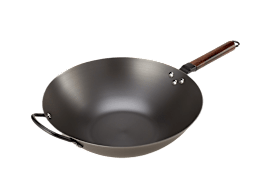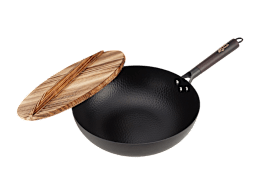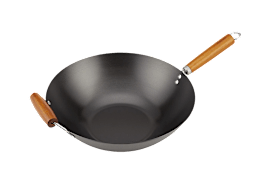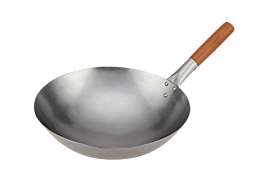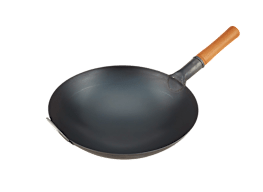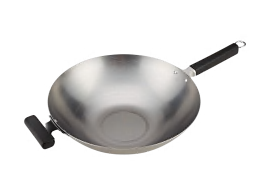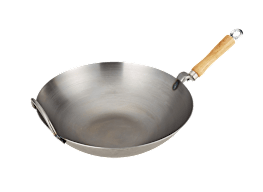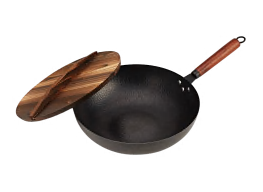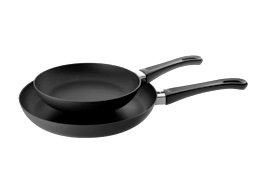Confessions of a First-Time Wok Buyer
Whether you’re buying a wok for the first time or you’re a seasoned user, read on for tips—and even learn from my mistakes
When you shop through retailer links on our site, we may earn affiliate commissions. 100% of the fees we collect are used to support our nonprofit mission. Learn more.
As an American-born Chinese kid, I grew up with a wok at home. I knew the smell and the specific sound of a steel ladle clanging against the wok. But because I didn’t do much of the Chinese cooking, I never used this kitchen staple.
As an adult, I didn’t have a wok of my own, but I’d go to Chinese restaurants where I knew I could hear that sound in the kitchen, where you’d find nearly bathtub-sized woks over intense flames I’d never achieve at home.
Why I Bought a Wok
At the onset of the pandemic, I was reluctant to dine out but still needed my Chinese food fix. Not the Americanized stuff from the fast-food place down the block, but the authentic stuff. That’s when I decided to finally buy my own wok.
At home, my stir-fry results just weren’t cutting it using my large cast-iron skillet. And I found myself chasing my ingredients around the edge of it. Julienned red bell peppers and shallots would flop over the side. I’d already been trying new things in the kitchen, so why not a wok?
After all, woks are versatile and economical. Their design makes them useful not just for stir-frying but also deep-frying, braising, and steaming, so there’s no need to buy a separate piece of cookware for each task. That makes them environmentally friendly and they can help you save space in a small kitchen.
“And think about how much oil you actually use when you have to coat the bottom of a 12-inch skillet vs. how much oil you need to use for a 14-inch wok, which has a very small center,” Young said.
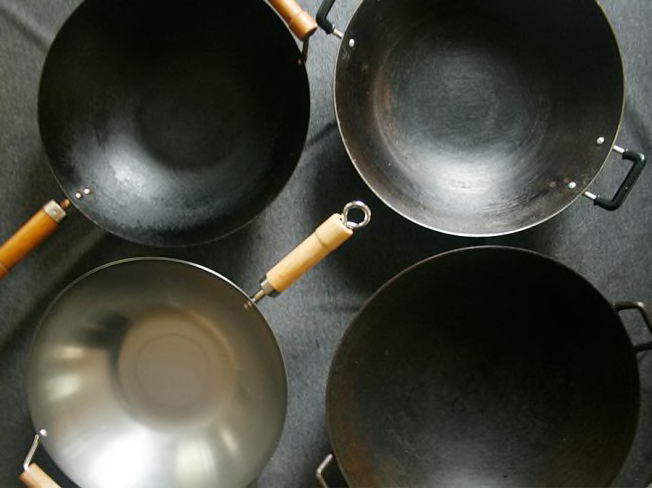
Photo: Grace Young Photo: Grace Young
Material Choices
There are three main types of woks: carbon steel, cast iron, and nonstick.
Carbon Steel
Carbon steel woks are durable while also being thinner and lighter than woks made of other materials. That’s why they’re so popular, says Sarah Leung, co-founder of The Woks of Life, a blog where you’ll find authentic Chinese recipes developed and shared by Leung and her family, including her parents, Bill and Judy, and her sister, Kaitlin. Carbon steel is also a good choice for beginners.
“Buy a lightweight carbon steel wok to start so you can familiarize yourself with the proper flipping technique without the extra weight of a cast-iron wok,” says Cesar Zapata, executive chef and co-owner of the Miami-based Vietnamese-Cajun fusion restaurants Phuc Yea and Pho Mo.
But not all carbon steel woks work with all induction cooktops, so if you have one of those, check the label attached to the wok you’re considering to see whether it’s induction compatible. Or use a magnet: If it sticks to the wok, it should work with an induction cooktop.
Cast Iron
I have traditional Chinese cast-iron purists in my family. My favorite wok-cooking memories are of my uncle Howard Chau, a chef and founder of Chau-Time, a catering company in Blaine, Wash. He would effortlessly toss ingredients in his thin Chinese cast-iron wok. At the time, I didn’t even realize it was made of cast iron, because the type you’d find in China is much thinner than the usual cast-iron pans you’d commonly find in the U.S.
“Old-fashioned Chinese home cooks love Chinese-made cast-iron woks, and feel these woks are the best for searing and stir-frying,” Young said. “They are lighter in weight than American-made cast iron but still much heavier than carbon steel.”
“I will use a traditional cast-iron wok for fried chicken and other deep-fried items, since it’s even better at maintaining a constant high temperature,” Zapata says.
Chinese cast-iron woks can be found online and in mom-and-pop stores such as The Wok Shop in San Francisco. Mainstream brands like Lodge and Cuisinart make heavier cast-iron woks.
“Whether American-made or Chinese-made, when using a cast-iron wok, the food must be removed immediately the moment it’s cooked, because cast-iron retains heat and will continue to cook the food if it’s left in the pan, leaving food overcooked,” Young said.
After stir-frying sliced beef and veggies in a cast iron wok, I learned this the hard way.
Nonstick
I imagine a shame-on-you headshake and finger wag from a Chinese relative when considering a nonstick wok. And there are several good reasons to avoid them.
For one thing, cooking in a wok generally requires high heat, which is discouraged by some nonstick cookware manufacturers.
What’s more, for the best results, a wok should be heated empty, Young said. And even manufacturers will say that heating a nonstick pan while empty is a no-no. Doing so can damage the pan and increase your chances of exposure to harmful fumes.
What’s more, cooking in anything nonstick means you can’t use metal utensils. And wood and silicone utensils just aren’t thin enough to effectively scoop meat and other ingredients off of the wok quickly enough, said Young, who doesn’t recommend nonstick woks.
Round Bottom vs. Flat Bottom
Traditional round-bottomed woks are great when you have a gas range and a wok ring for stability, because flames can reach higher up the sides of your pan. But you wouldn’t want to use one on a smoothtop electric range. It will wobble, and very little surface area will actually be in contact with your heat source. With a smoothtop electric range, like the one that came with my Brooklyn apartment, a flat-bottomed wok is the best bet, because more of the wok will touch the heat source, Young said.
Wok Utensils That Experts Recommend
Do use: A stainless steel spatula with a thin, rounded edge that can easily slide between your food and your wok, Young said.
Don’t use: A wooden spatula or tongs. Wooden spatulas are too thick to fit under food as quickly as you need it to when you’re cooking on high heat, Young said. Tongs also don’t move food around fast enough, which can result in burned food in some areas and nearly uncooked food in others.
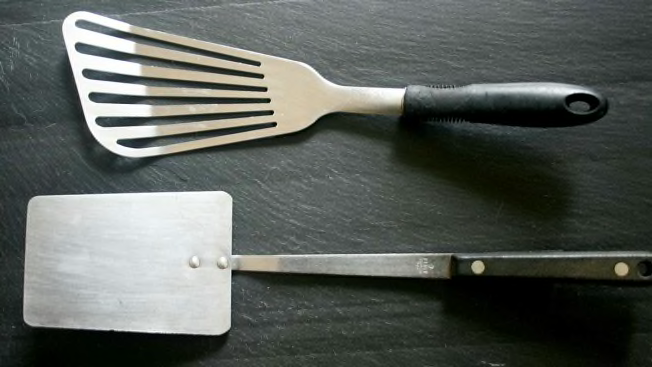
Photo: Grace Young Photo: Grace Young
How to Season a New Wok
If you buy a carbon steel or cast-iron wok that needs to be seasoned (a label will tell you whether it is already), first scrub it with a stainless steel scrubber and dish soap, inside and out, Young said. There may still be a coating on the wok from manufacturing.
Then, according to The Woks of Life, you should protect your wok handles by wrapping them in aluminum foil. Next, tilt your wok over your burner on full blast, making sure every area of the wok is heated until it turns black and blue. Let it cool, give it a scrub, wipe it with a paper towel, and dry it on your stove on medium heat. Spread a tablespoon of oil that has a high smoke point, such as avocado, canola, or peanut, all over the inner surface of your wok, then wipe it with a paper towel.
As part of the seasoning process, you can also stir-fry Chinese chives, scallions, or onions, which will practically embed their fragrance into your wok.
It’s much harder to adequately season a wok if you have an electric cooktop, Young said when I explained to her my own wok anxiety. First, you’ll need a flat-bottomed wok for it to even stay steady on your burner. Even then, it could be that only the flat surface will get that beautiful black patina you’ll find on woks that have been used daily for decades, she said.
Because I have a smoothtop range at home, Young suggested that if I have a friend who has a semiprofessional one like a Wolf or a Viking, I should just stir-fry there a few times to help season my wok higher up from the bottom than I can achieve at home.
Even then, “don’t get caught up in the look of the wok,” Young said. “For the first year, the pan will look like you made a mistake.” A carbon steel can turn orange, blue, or black. It could look like you ruined the pan. It could look splotchy, even rusty. The patina will develop over time, with lots of use. Deep-frying and popping popcorn in your wok can speed up this process, she said.
A cast-iron wok can be seasoned the same way.

Photo: Althea Chang-Cook/Consumer Reports Photo: Althea Chang-Cook/Consumer Reports
How to Start Using a Wok
One of the most important things I’ve learned about cooking in a wok is that it needs to reach a high temperature and maintain it. Before you put anything in your wok, make sure it’s hot, Young said.
Sophina Uong, chef and owner of Mister Mao, a restaurant in New Orleans, says, “let it get piping hot—I mean really, almost scary, hot!” Uong also stresses the importance of mise en place, or having all of your ingredients ready to go ahead of time.
If you’re stir-frying, you’re likely combining several ingredients to make one dish. In that case, you may have some harder vegetables that need to be cooked longer than other ingredients.
One trick to make sure you have all your ingredients ready to eat at the same time is to par-cook those harder ingredients separately first, before mixing them into your stir-fry, Leung says. You can do this by steaming them or by blanching them, which means you boil them briefly, place them in an ice bath, and drain them before you toss them into your wok.
Sauces should be prepped, vegetables should be cut uniformly and steamed or blanched if necessary so that all your ingredients are cooked properly—not too much, not too little—all at the same time, Uong says.
“Mise en place is king,” because food cooks very quickly in a wok, Zapata says. Once your ingredients are in your wok, toss your food correctly by pulling the pan toward you before pushing it away, he says.
Pro tip: You can flip over any carbon steel or cast-iron wok and use it as a surface to make flatbreads on, Uong says. It’s a technique used at her restaurant. If your wok has wooden handles though, you may want to cover them with foil.
What to Avoid When Cooking With a Wok
To keep meat looking fresh and prevent noodle dishes from becoming a pile of mush, I’ve learned some tough lessons the hard way.
Too much meat: If you cook too much meat at a time, there could be so much liquid produced that you’ll end up braising instead of frying, which can turn red meat an unappetizing gray color.
Young advised against stir-frying more than 12 ounces of beef or more than a pound of pork, chicken, duck, or shrimp. And when adding meat to a hot wok, she likes to spread pieces in the wok and avoid touching them for the first minute so they begin to sear. After that, she’ll start the actual stir-frying.
Crowding: Whatever your ingredients, don’t crowd your wok. “Avoid cooking in batches that are too large,” Leung says. “You need to control the amount of moisture and other cooling influences on your wok that will bring its temperature down.”
Water: Young advised against using a new wok for steaming, boiling, poaching, or braising. This can damage the patina that’s still developing.
Cleaning: Don’t wash your wok the way you may wash your dishes, Young said. And don’t use a scouring pad. Instead, to preserve that natural nonstick surface, give it a gentle rub with a regular sponge under running water. For more stubborn burned-on bits of food, use the coarse side of a Scotch Brite or similar sponge. Whether you have a carbon steel wok or a cast-iron one, anything more abrasive can damage the seasoned surface you’ve worked to achieve, and you’ll have to season it all over again to keep food from sticking.
Top Woks From CR's Tests
These carbon steel woks top Consumer Reports’ ratings for cooking evenness and performed well in our tests of how quickly they can heat up.

















